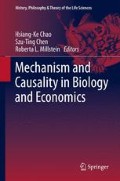Abstract
Recent discussions of natural selection focus on two questions: first, is natural selection a causal process or is it a statistical consequence of lower-level events? And second, is natural selection at the population level or at the level of individuals? Bouchard and Rosenberg (Br J Philos Sci, 55:693–712, 2004) argue that natural selection is causal and at the level of individuals, as opposed to Matthen and Ariew (J Philos, 99:55–83, 2002) and Walsh et al. (Philos Sci, 69:452–473, 2002), who argue that natural selection is at the population level and purely statistical. In addition to these two polar extreme positions, Millstein (Br J Philos Sci, 57:627–653, 2006) tries to steer a middle course by arguing that natural selection is a population-level causal process. I will make three points in this chapter: first, Millstein’s account of natural selection is incomplete, in the sense that nowhere in her account can one find a place for cases of natural selection-of. Second, we should prefer Brandon’s account of natural selection and drift over Millstein’s, on the grounds that her account fails to meet a plausible requirement that Brandon’s account succeeds in meeting: namely, whenever natural selection and drift operate together, a change in the strength of natural selection implies an inverse change in the strength of drift, and vice versa. Third, the prospects of the view that natural selection is a population-level causal process depend on a satisfactory solution to both the epiphenomenon and the overdetermination problems. With the help of an analogy, I will show how the two problems can be dealt with.
Access this chapter
Tax calculation will be finalised at checkout
Purchases are for personal use only
Notes
- 1.
As an anonymous referee points out, Brandon’s views on drift may have changed since 2005. Because my paper focuses on Brandon’s (2005) argument where he responds directly to Millstein, I will not refer to Brandon’s (2006) “The Principle of Drift: Biology’s First Law,” where he seems to offer a fleshed out alternative view of drift.
- 2.
Note that Brandon deliberately separates deviation from sampling error in using the expression “due to,” which suggests, among others, that he views deviation as outcome and unrepresentative sampling/sampling error as process.
- 3.
In an infinite population, it is extremely unlikely that deviation arises. Alternatively speaking, it is extremely likely that sampling process is representative.
- 4.
I leave open an interesting question as to whether natural selection, operating at the population level, is as causally robust as the many events occurring at the individual level. Stuart Glennan (2009) distinguishes causal relevance and causal productivity and argues that at the population level of natural selection, there can be causal relevance without causal production. In response, Millstein (2013) argues that there is causal production at the population level of the natural selection process.
References
Beatty, J. 1984. Chance and natural selection. Philosophy of Science 51: 183–211.
Bouchard, F., and A. Rosenberg. 2004. Fitness, probability, and the principles of natural selection. The British Journal for the Philosophy of Science 55: 693–712.
Brandon, R. 2005. The difference between selection and drift: A reply to Millstein. Biology and Philosophy 20: 153–170.
Brandon, R. 2006. The principle of drift: Biology’s first law. Journal of Philosophy 102: 319–335.
Brandon, R. 2010. Natural selection. In The Stanford encyclopedia of philosophy (Fall 2010 Edition), ed. Edward N. Zalta. URL: http://plato.stanford.edu/archives/fall2010/entries/natural-selection/
Brandon, R., and S. Carson. 1996. The indeterministic character of evolutionary theory: No “no hidden variables proof” but no room for determinism either. Philosophy of Science 63: 315–337.
Glennan, S. 2009. Productivity, relevance, and natural selection. Biology and Philosophy 24: 325–339.
Hartl, D.L., and A.G. Clark. 1989. Principles of population genetics. Sunderland: Sinauer Associates.
Matthen, M., and A. Ariew. 2002. Two ways of thinking about fitness and natural selection. Journal of Philosophy 99: 55–83.
Millstein, R.L. 2002. Are random drift and natural selection conceptually distinct? Biology and Philosophy 17: 33–53.
Millstein, R.L. 2005. Selection vs. Drift: A response to Brandon’s reply. Biology and Philosophy 20: 171–175.
Millstein, R.L. 2006. Natural selection as a population-level causal process. The British Journal for the Philosophy of Science 57: 627–653.
Millstein, R.L., and R.A. Skipper Jr. 2007. Population genetics. In The Cambridge companion to the philosophy of biology, ed. D. Hull and M. Ruse, 22–43. Cambridge: Cambridge University Press.
Millstein, R.L. 2013. Natural selection and causal productivity: A reply to Glennan. In Mechanism and causality in biology and economics, ed. Hsiang-Ke Chao, Szu-Ting Chen, and Roberta L. Millstein, 147–163. Dordrecht: Springer.
Shapiro, L., and E. Sober. 2007. Epiphenomenalism—The do’s and the don’ts. In Studies in causality: Historical and contemporary, ed. G. Wolters and P. Machamer, 235–264. Pittsburgh: University of Pittsburgh Press.
Sober, E. 1984. The nature of selection. Cambridge, MA: MIT Press.
Walsh, D.M., T. Lewens, and A. Ariew. 2002. The trials of life: Natural selection and random drift. Philosophy of Science 69: 452–473.
Acknowledgements
I am extremely grateful to Roberta L. Millstein for comments that led to substantial improvements in the final version of this chapter. I would like to thank an anonymous referee who helped me to clarify the issues discussed here. I am grateful to Hsiang-Ke Chao and Szu-Ting Chen for organizing the wonderful conference. I gratefully acknowledge support from the National Science Council, Taiwan (NSC98-2410-H-031-002-MY3).
Author information
Authors and Affiliations
Corresponding author
Editor information
Editors and Affiliations
Rights and permissions
Copyright information
© 2013 Springer Science+Business Media Dordrecht
About this chapter
Cite this chapter
Wang, RL. (2013). Is Natural Selection a Population-Level Causal Process?. In: Chao, HK., Chen, ST., Millstein, R. (eds) Mechanism and Causality in Biology and Economics. History, Philosophy and Theory of the Life Sciences, vol 3. Springer, Dordrecht. https://doi.org/10.1007/978-94-007-2454-9_9
Download citation
DOI: https://doi.org/10.1007/978-94-007-2454-9_9
Published:
Publisher Name: Springer, Dordrecht
Print ISBN: 978-94-007-2453-2
Online ISBN: 978-94-007-2454-9
eBook Packages: Humanities, Social Sciences and LawPhilosophy and Religion (R0)

